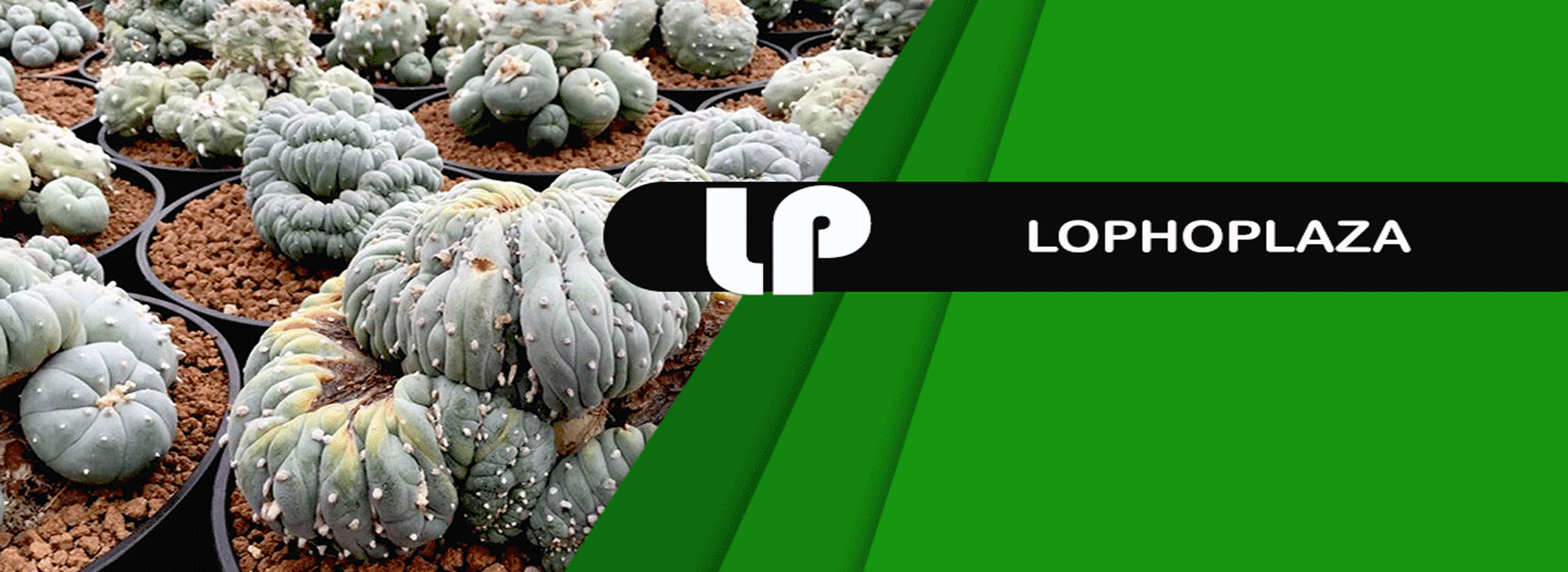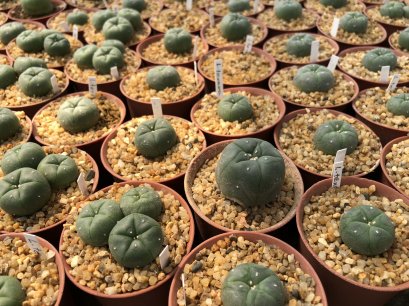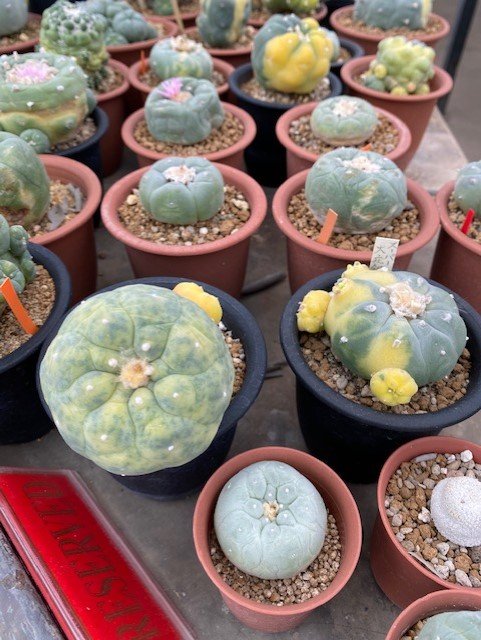LOPHOPLAZA
Welcome to the home of the lophoplaza cactus, the infamous lophophora williamsii also known as peyote.
My garden was born from a cactus lover, set up by children. I have accumulated a lot of cactus from anywhere in Thailand. My favorite cactus is the lophophora.So my garden has many lophophora.
You will find here information on how to grow a peyote cactus from seeds and care about all your favourite plants: lophophora, trichocereus, astrophytum, ariocarpus, but also aloe vera and carnivorous plants. The main purpose here is to help, save, conserve and preserve lophophora williamsii and all endangered species. We only sell seeds and plants in order to be ornament and to save endangered species, we provide informations about the culture of native american indian civilization but we don't encourage anyone to get intoxicated, at it is really dangerous for health and against the law of some countries.
Taxonomic Hierarchy
Kingdom: Plantae - plantes, planta, vegetal, plants
Subkingdom: Viridiplantae - green plants
Infrakingdom: Streptophyta - land plants
Superdivision: Embryophyta
Division: Tracheophyta - vascular plants, tracheophytes
Subdivision: Spermatophytina - spermatophytes, seed plants
Class: Magnoliopsida - flowering plants
Superorder: Caryophyllanae
Order: Caryophyllales
Family: Cactaceae - cactus, cacti
Genus: Lophophora J.M. Coult.
Species: Lophophora williamsii (Lem. Ex Salm-Dyck) J.M. Coult. - Peyote, peyote
Lophophora is a generic name. The full name is called Lophophora J.M. Coult. By J.M. Coult comes from Coulter, John Merle, who is the botanist of this species. He is an American botanist. With a life span from birth to death in the years 1851-1928
As with other scientific names, Lophophora comes from two ancient Greek / Latin words with the word "lophos", "lophi" meaning the crest of a hill or helmet and the word "phoro-, phor-, - phora, -phorous, -phoresis, -phore, -phori, -phoria "means to carry, to bear. Overall, Lophophora means crest-bearing Which comes from the top growth characteristics And there is a fluff from the blister or the hill of the thorn that is his top
Which is the name of the genus, and let's give an example of the species as well. The first name or the first species to be described is Lophophora williamsii that we know well. Originated in Mexico and southwestern Texas. There is a common name that is the Spanish peyote, which is derived from the word "peyotl" in the ancient Nahuatlan language (ancient Indian language Or local tribes in Mexico a long time ago), but some linguists say that it is a word from the language of the Aztec tribe. The word "pepyoni" means to excite or the word "pepeyon" that means to activate. Both words have similar meanings. "Awakening symptoms", which is due to the origin and roots of this species, have psychoactive alkaloid substances, especially those of mescaline (hallucinogen), which are substances that affect the nervous system. Causing amnesia Hallucination By the indigenous people in Mexico used as a drug and used for religious ceremonies (as "Divine Messenger" helped to send the message to God) for a long time Which will be boiled with water to drink, similar to drinking tea Or can be dried for storage for a long time And makes the substance more concentrated as well The fact that he had neurotransmitters made many countries banned the sale. Or in possession, such as in the USA and the UK, etc. and recently this tree was used to make wax (ointment) which is sold only in Mexico. In the nursery, there is very little or no amount of mescaline residue.
That he had told the story better than the Lophophora williamsii or the peyote. With the scientific name Lophophora williamsii (Lem. Ex Salm-Dyck) JM Coult. The name JM Coult has been described as the family name, but the species that wrote Lem. Are from Lemaire, Antoine French botanist Charles (Also named Astrophytum) and Salm-Dyck are the names of Joseph zu Salm-Reifferscheidt-Dyck. Or his long, full name is Joseph Franz Maria Anton Hubert Ignatz Fuerst und Altgraf zu Salm-Reifferscheidt-Dyck A German amateur botanist As far as finding information, he understood that before being named Lophophora williamsii, it was originally named Echinocactus williamsii by Charles Lamaire named in honor of Sir. CH Williams (the British Ambassador to the state of Bahia). ........... * end *
Kingdom: Plantae - plantes, planta, vegetal, plants
Subkingdom: Viridiplantae - green plants
Infrakingdom: Streptophyta - land plants
Superdivision: Embryophyta
Division: Tracheophyta - vascular plants, tracheophytes
Subdivision: Spermatophytina - spermatophytes, seed plants
Class: Magnoliopsida - flowering plants
Superorder: Caryophyllanae
Order: Caryophyllales
Family: Cactaceae - cactus, cacti
Genus: Lophophora J.M. Coult.
Species: Lophophora williamsii (Lem. Ex Salm-Dyck) J.M. Coult. - Peyote, peyote
Lophophora is a generic name. The full name is called Lophophora J.M. Coult. By J.M. Coult comes from Coulter, John Merle, who is the botanist of this species. He is an American botanist. With a life span from birth to death in the years 1851-1928
As with other scientific names, Lophophora comes from two ancient Greek / Latin words with the word "lophos", "lophi" meaning the crest of a hill or helmet and the word "phoro-, phor-, - phora, -phorous, -phoresis, -phore, -phori, -phoria "means to carry, to bear. Overall, Lophophora means crest-bearing Which comes from the top growth characteristics And there is a fluff from the blister or the hill of the thorn that is his top
Which is the name of the genus, and let's give an example of the species as well. The first name or the first species to be described is Lophophora williamsii that we know well. Originated in Mexico and southwestern Texas. There is a common name that is the Spanish peyote, which is derived from the word "peyotl" in the ancient Nahuatlan language (ancient Indian language Or local tribes in Mexico a long time ago), but some linguists say that it is a word from the language of the Aztec tribe. The word "pepyoni" means to excite or the word "pepeyon" that means to activate. Both words have similar meanings. "Awakening symptoms", which is due to the origin and roots of this species, have psychoactive alkaloid substances, especially those of mescaline (hallucinogen), which are substances that affect the nervous system. Causing amnesia Hallucination By the indigenous people in Mexico used as a drug and used for religious ceremonies (as "Divine Messenger" helped to send the message to God) for a long time Which will be boiled with water to drink, similar to drinking tea Or can be dried for storage for a long time And makes the substance more concentrated as well The fact that he had neurotransmitters made many countries banned the sale. Or in possession, such as in the USA and the UK, etc. and recently this tree was used to make wax (ointment) which is sold only in Mexico. In the nursery, there is very little or no amount of mescaline residue.
That he had told the story better than the Lophophora williamsii or the peyote. With the scientific name Lophophora williamsii (Lem. Ex Salm-Dyck) JM Coult. The name JM Coult has been described as the family name, but the species that wrote Lem. Are from Lemaire, Antoine French botanist Charles (Also named Astrophytum) and Salm-Dyck are the names of Joseph zu Salm-Reifferscheidt-Dyck. Or his long, full name is Joseph Franz Maria Anton Hubert Ignatz Fuerst und Altgraf zu Salm-Reifferscheidt-Dyck A German amateur botanist As far as finding information, he understood that before being named Lophophora williamsii, it was originally named Echinocactus williamsii by Charles Lamaire named in honor of Sir. CH Williams (the British Ambassador to the state of Bahia). ........... * end *



Powered by
MakeWebEasy.com










